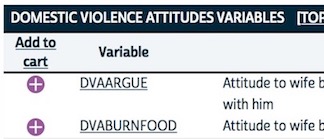Home » Data » IPUMS Demographic and Health Surveys (IPUMS-DHS) » IPUMS-DHS Tip #5: Check who was included in a sample
| IPUMS-DHS Tip #5: Check who was included in a sample [message #15385] |
Mon, 09 July 2018 19:42  |
 kingx025
kingx025
Messages: 95
Registered: August 2016
Location: Minneapolis. Minnesota
|
Senior Member |
|
|
While the most common specification for who was included in the women's IR files is women age 15-49 and the most common specification for the child/KR files is children under 5, researchers working with more than 1 survey need to confirm just who is included among "women of childbearing age" and "young children" for a given survey. IPUMS-DHS can answer this question, through the Sample Descriptions page, here: https://www.idhsdata.org/idhs/samples.shtml
and through the Universe tab for variables such as:
V012 (AGE of woman) https://www.idhsdata.org/idhs-action/variables/AGE#universe_ section
and B8 (KIDCURAGE): https://www.idhsdata.org/idhs-action/variables/KIDCURAGE#uni verse_section
Checking who was included in the IR (individual woman) and KR (child) files is important even if you are looking at changes in a single country over time. Consider the standard DHS surveys for India:
India 1992: Ever-married women age 13-49, children age 0-3
India 1998: Ever-married women age 15-49, children age 0-2
India 2005: All women age 15-49, children age 0-4
India 2015: All women age 15-49, children age 0-4
You can readily see that if you don't adjust your data to make the sampling frame comparable for women and children in these 4 surveys, summary statistics and multivariate analyses could give very misleading results when comparing results over time. For example, the proportion of women using contraception will be higher for ever-married women than for all women, and the proportion of children still breastfeeding will be higher for a sample of children age 0-2 than for a sample of children age 0-4.
While many countries used consistent framing for the population of women and young children surveyed over time, it's a good idea to check and adjust as necessary. Many countries did change the composition of their sample of women and children over time; for example, Bangladesh always surveyed ever-married women but the women's starting age ranged from 10 to 12 to 15. Many surveys from the 1990s asked about children born in the 3 or 4 years before the survey, not born in the 5 years before the survey. Checking the population of women and young children included is essential if you are looking at multiple countries.
Information on the age ranges of women and children and whether the sample is restricted to ever-married women is included in the original documentation for DHS files, but IPUMS-DHS brings this information together for quick viewing online.
The question of who was included is also salient for data on men, who vary in their age range and in whether all men or only husbands of surveyed women are included. IPUMS-DHS will be making data on men available in Spring 2019, and we will add this information on men to the Sample Characteristics page at that time.
Miriam King
Dr. Miriam King
IPUMS-DHS Project Manager (www.idhsdata.org)
|
|
|
|
| Re: IPUMS-DHS Tip #5: Check who was included in a sample [message #15478 is a reply to message #15385] |
Sun, 29 July 2018 13:33  |
 boyle014
boyle014
Messages: 78
Registered: December 2015
Location: Minneapolis
|
Senior Member |
|
|
mrarad emailed: "how can i get this information for my own country?" Good question. The answer is typically through the UNIVERSE tab.
The variable names in IPUMS DHS are links to more information. For example, below, DVAARGUE and DVABURNFOOD are clickable links.

When you click on the link, there are a series of tabs across the top of the screen: CODES, DESCRIPTION, COMPARABILITY, UNIVERSE, AVAILABILITY, and SURVEY TEXT. You can see these in the image below. The UNIVERSE tab, shown below for DVAARGUE, is where you will find the information mentioned in Miriam King's post. In this example, I selected surveys from Bangladesh, India and Pakistan. You can see that there are some universe differences across the different samples.

Hope this helps. Good luck with your research!
Professor Elizabeth Boyle
Sociology & Law, University of Minnesota, USA
Principal Investigator, IPUMS-DHS
|
|
|
|
Goto Forum:
Current Time: Sun Jul 13 04:40:17 Coordinated Universal Time 2025
|
 The DHS Program User Forum
The DHS Program User Forum
 Members
Members Search
Search Help
Help Register
Register Login
Login Home
Home








